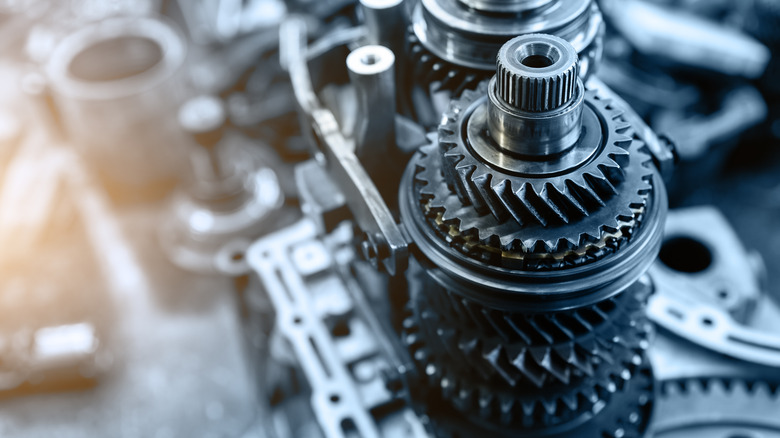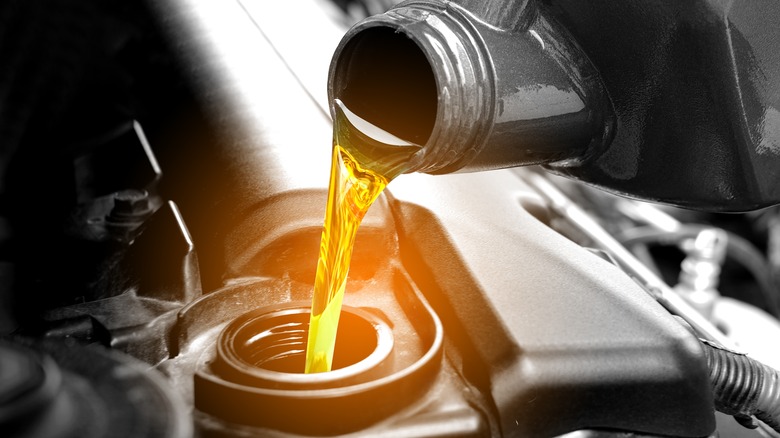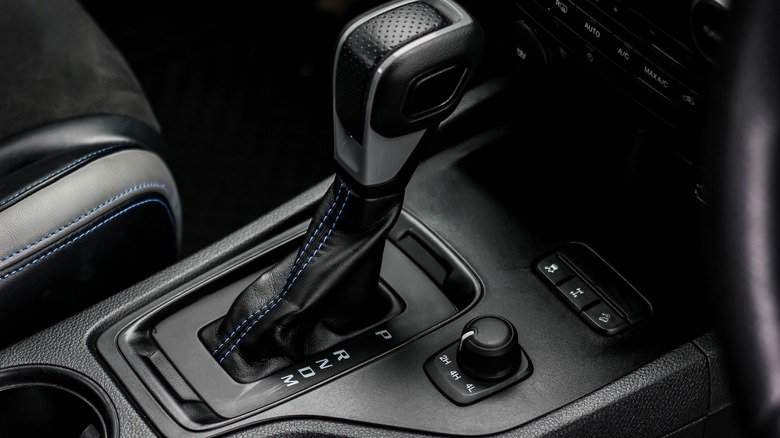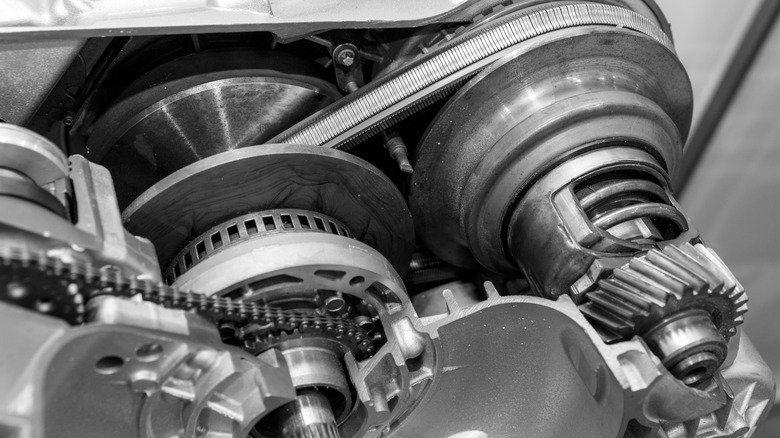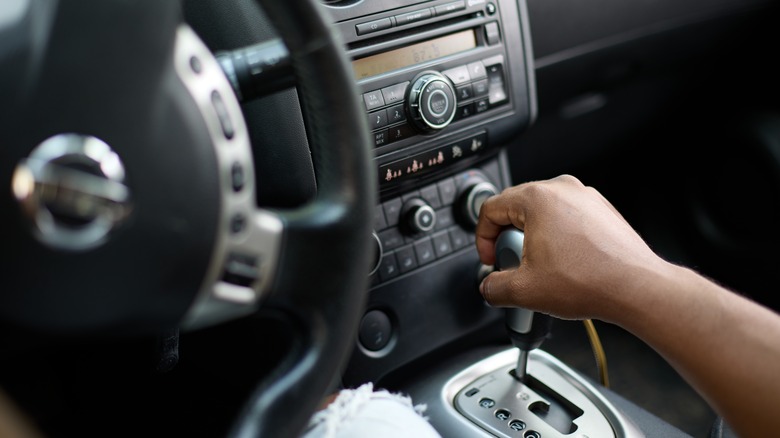Do Manual Transmissions Cost Less To Maintain Than Automatic?
The average vehicle consists of countless components, from nuts and bolts to big, crucial elements like the steering wheel, tires, and gearbox. It's almost inevitable that some of them will misbehave at some point. But between a manual and automatic, which is more likely to break the bank to buy, drive, and maintain?
Automatics lack clutch pedals because they aren't needed. Through a sophisticated system of electronics and hydraulics, an automatic transmission can determine the speed of the vehicle and change gears on the fly in response to this information. Manuals, on the other hand, are much more demanding for the driver, who must continually change gears themselves. To do this, they first use the clutch to cut the transmission's connection to the engine and then select the appropriate gear using their gearstick. The system of gears (hence the name) is controlled by a series of shift forks, which move to hold the desired setting when the clutch is released again. Timing is crucial, as it's easy to stall a vehicle if you mistakenly let go of the clutch at the wrong time. Manuals can be complex beasts.
Manuals and automatics each have pros and cons, and it's for the driver to decide which is right for them. Historically an automatic was considered more expensive, owing to the sophisticated technology that replaces the manual transmission as well as fuel efficiency. But while it was once commonly held that manuals were cheaper than automatics, more recently, things have shifted.
General maintenance costs for manuals versus automatics
Aviva notes that an automatic's broader maintenance needs are a mixed bag. It will perform its gear-shifting duties by itself consistently, meaning human error is removed from the equation and the transmission will be more reliable all-around. A driver cannot overwork an automatic transmission or potentially damage it with poor gear shift work, but by the same token, they cannot perform even more efficient gear stick work either.
Gearbox & Axle Centre suggests that an automatic transmission should be taken in for maintenance between every 60,000 to 100,000 miles driven. For a manual, the 30,000 to 60,000 miles range is suggested. If manuals are taken to the shop more frequently (broadly speaking), costs could be greater for any transmission maintenance that an automatic requires, because the components and work are correspondingly more complicated.
Bumper found in 2024 that the average cost of replacing a manual gearbox (up to $3530 or so for a 2.0L+ vehicle) was costlier than for an automatic (up to $2900 for a DSG gearbox or equivalent). Clearly, then, the current picture of the respective price of maintaining manuals and automatics is difficult to gauge, because so much depends on whether a transmission is repaired or replaced, what type of vehicle you're driving in the first place, and so much more besides. Individual circumstances further muddy the waters because they have such an influence on transmission maintenance needs.
Fuel Efficiency
There's a notion that manuals operate more efficiently, and this has long been the case. Moreover, Car.co.uk suggests that automatics used to be more limited, with the capacity for only around four gears and more heft as a result of the components used. The price for convenience, it could be said, was less optimal performance. However, automatics with sizable torque converters have been in use in the U.S. since the Buick Dynaflow, a transmission that debuted in 1948. Automatic transmissions today needn't be great, antiquated machines. They will tend to weigh more, which can correspondingly make the engine work harder, but technological developments have resulted in more efficient automatics.
The 2023 EPA Automotive Trends Report concluded that "modern automatic transmissions are now more efficient." This was partially attributed to the fact that gear ratio options were expanding more quickly for them than for their manual counterparts (though stick shifts have advanced too).
CVTs (Continuously Variable Transmissions), for instance, offer many more gear options than the drivers of early automatics could ever have dreamed of, and the longer a vehicle remains in the perfect gear ratio for its speed, the more efficiently it will run. As such, it may be possible for a deftly driven manual to outperform an automatic, but for those who aren't so technically inclined, an automatic can certainly be an efficient proposition. Let's see just how CVTs work.
What about CVTs?
These transmissions are not constrained by a limited number of different gear options as conventional automatics and manuals are, typically utilizing pulleys to provide almost unlimited gears. This can translate to an engine that never "wastes" power and always runs at optimal efficiency, which can result in lower running costs. In addition, a CVT doesn't have as many complex parts as an automatic, and so can be cheaper to make. Maintenance costs, however, can be more expensive, as such a transmission is more uncommon and so more specialized.
A CVT works by transporting torque to the wheels using the steel belt connecting the pulleys. However, there are other more uncommon varieties, including the ECVT (an electronic version with a planetary gearbox) and Toroidal CVT, which revolves — quite literally — around the action of two turning disks, the input and output disks. Between them, they connect the drive shaft and the engine, and through the power of friction as they move, deliver the force where it's needed to keep the vehicle in the appropriate gear in response to its movement. In addition, this system results in quiet operation, though that very same operation is very physical by nature, and costly repair or replacement servicing could be required.
In 2022, Callahan Automotive reported that a CVT can be expected to last for around 100,000 miles, but can potentially reach double that with careful use. Driving styles and habits are another crucial aspect of the manual-or-automatic question.
The potential impact of driving styles and conditions
In 2023, J.D. Power reported, according to Wards Auto, that of all new vehicles sold in the United States that year, 98.3% boasted automatic transmissions. Manual drivers who appreciate the thrill of the direct control such a transmission offers are in the minority across the country. This direct control can have both a positive and negative effect on potential maintenance costs.
The RAC warns that habits like keeping a ready foot on the clutch or hand on the gearshift can cause unnecessary wear on a manual transmission, matters that automatic drivers needn't concern themselves with. In addition, the latter can potentially switch between gears faster than the former, in around 8 milliseconds (the average driver needs approximately half a second to a second to act), which has tiny advantages in efficiency that can eventually add up. The amount of gear-changing wear a transmission is subject to, more broadly, is dependent on the terrain and the weather conditions in which a driver is traveling.
Colder conditions can put strain on a transmission by thickening transmission fluid and reducing its efficiency, or even causing excess water to freeze inside. The unpredictable nature of extreme cold can make manuals more efficient and potentially safer to drive, affording the driver more direct gear control, while extreme heat can heighten the risk of an automatic transmission overheating more so than with a manual (as they typically work harder and can become hotter).
The reality of comparing costs
If you're in the market for a new (or a new-to-you) vehicle, you'll still typically find that an automatic will be more expensive than an equivalent manual at the outset. In terms of insurance, too, keeping your automatic in good working order can work out more expensive. In 2016, Admiral concluded that automatic drivers make claims almost 50% more frequently than drivers of manuals. The Admiral Pricing Team went on to note that insurance premiums for vehicles with automatic transmissions were approximately 5.63% more expensive than the equivalent for their manual counterparts.
Automatics have also been more expensive in terms of fuel efficiency, as the process demands more energy from the engine. Over the years, though, they have advanced significantly to compensate for this. As of January 2023, Green Car Guide suggests, there may be minimal MPG differences between comparable engines. In more challenging climates, a manual may perform better overall, while the advanced functionality of automatics in heavy-traffic urban areas could make automatics a more economical pick. A driver with a history of being rather heavy-handed with manuals may find that an automatic that reins them in may wear less in the long run, thereby reducing the frequency of maintenance trips and cutting costs. It's not just about the vehicle, but where and how you'll be driving it.
